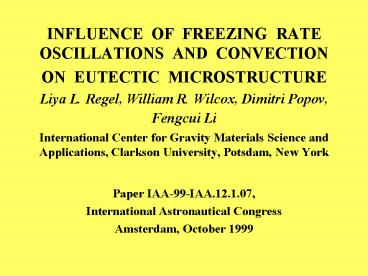INFLUENCE OF FREEZING RATE OSCILLATIONS AND CONVECTION - PowerPoint PPT Presentation
1 / 35
Title:
INFLUENCE OF FREEZING RATE OSCILLATIONS AND CONVECTION
Description:
INFLUENCE OF FREEZING RATE OSCILLATIONS AND CONVECTION ON EUTECTIC MICROSTRUCTURE Liya L. Regel, William R. Wilcox, Dimitri Popov, Fengcui Li – PowerPoint PPT presentation
Number of Views:59
Avg rating:3.0/5.0
Title: INFLUENCE OF FREEZING RATE OSCILLATIONS AND CONVECTION
1
- INFLUENCE OF FREEZING RATE OSCILLATIONS AND
CONVECTION - ON EUTECTIC MICROSTRUCTURE
- Liya L. Regel, William R. Wilcox, Dimitri Popov,
Fengcui Li - International Center for Gravity Materials
Science and Applications, Clarkson University,
Potsdam, New York - Paper IAA-99-IAA.12.1.07,
- International Astronautical Congress
- Amsterdam, October 1999
2
Outline
- Background
- Experiments on MnBi-Bi showing influence of
convection during solidification on MnBi fiber
spacing l. - Theory for influence of convection on l via
change in composition of the melt at the freezing
interface - Application of electric current pulses during
solidification of MnBi-Bi eutectic. - Theory for influence of an oscillatory freezing
rate on l. - Conclusions
3
(No Transcript)
4
T above melting point
melt
Insulated or linear DT
solid
T below melting point
V
Bridgman-Stockbarger Technique
5
- Prior experimental results on MnBi shown on
following slides. - Larson Pirich Microgravity and magnetic field
lower MnBi fiber spacing by same amount. - Mustafa and Smith Microgravity has no effect
on fiber spacing. - Eisa and Wilcox ACRT stirring increases fiber
spacing.
6
(No Transcript)
7
(No Transcript)
8
(No Transcript)
9
Prior Theory at Clarkson
- Convection causes the interfacial melt
composition to deviate less from the eutectic for
given ?. This increases ? for minimum
undercooling. Negligible, however, for
buoyancy-driven convection - Negligible difference if include Soret effect,
fibers versus lamellae, one phase leading the
other.
10
Convection lowers the compositional undercooling.
11
The following slide shows the results of Caram
and Wilcox for the influence of convection on the
composition at the freezing interface with rod
growth of a eutectic. On the left is the
composition field without convection for a
rectangular area that intersects 4 rods. On the
right is the same area with melt flow in the x
direction.The next slide shows the increase in
rod spacing (vertical scale) with increasing melt
velocity (horizontal scale).
12
Interfacial melt composition of fibrous eutectic
13
(dU/dz)lo2/D
14
Possible Explanations for experiments
- The bulk melt is not at the eutectic composition,
greatly increasing sensitivity to convection. - The average interfacial composition is not at the
eutectic because the material does not freeze
with minimum undercooling (extremum). - The freezing rate fluctuates, with different
kinetics for fiber termination and nucleation. - A habit-modifying impurity is present.
Convection changes its concentration at the
growth interface.
15
(No Transcript)
16
Cross sections of MnBi/Bi eutectic solidified at
4.3 cm/hr a no current d 3s pulses of 40
A/cm2 with 6s period
17
With current pulses, some grains exhibit
irregular microstructures or lack MnBi
completely. V2.1cm/hr, t4.5s, T18s, I40A/cm2
18
X 1.1cm/hr ? ? 4.4cm/hr ? 2.1cm/hr ?
5.5cm/hr ? 2.1cm/hr. Different current pulsing
conditions.
19
Rod spacing ? versus positive current density. ?
V1.1cm/hr, t0.25s, T2s () ? continuous ?
V2.1cm/hr, t0.75s, T6s () ? V2.1cm/hr,
t4.5s, T18s () ? continuous ? V4.3cm/hr,
t3s, T6s () ? continuous
20
Average rod spacing ? for negative current
? V4.4cm/hr, t3s, T6s (-) ?
V5.5cm/hr, t3s, T6s (-)
21
Area percent MnBi versus current density
22
Rod roundness versus average ?. ? no current
? 40 A/cm2 contin ? 8A/cm2 X 40 A/cm2
? 72 A/cm2
23
Theories for Oscillatory Freezing Rate
- All with no convection in the melt.
- Sharp interface model (no interface curvature)
- - Specified freezing rate oscillations
- - One phase leading the other
- - Nucleation when supersaturation sufficient
- Minimum entropy production model
- Phase field model
- - Curvature, nucleation, termination all occur
- naturally.
24
(No Transcript)
25
(No Transcript)
26
(No Transcript)
27
(No Transcript)
28
(No Transcript)
29
Steady-state example of phase-field modeling of
eutectic solidification
30
Phase-field simulation of the evolution of a
lamellar microstructure caused by decreasing the
freezing rate (top to bottom).
31
Phase-field simulation of the evolution of a
lamellar microstructure caused by increasing the
freezing rate (top to bottom).
32
Evolution of the interface shape when the
freezing rate oscillates with insufficient
amplitude to nucleate or terminate lamellae.
Note that the angles at which the phases meet at
the tri-junctions remain constant while the
volume fractions of the two phases change
slightly. Here (d) corresponds to the maximum
freezing rate and (g) the minimum freezing rate.
33
Result from entropy production model
34
Entropy production predicts small change in l
35
SUMMARY
- Literature shows convection increases l.
- Prior theory for steady state with eutectic
composition in bulk and at freezing interface
shows buoyancy-driven convection has negligible
influence on l. - Electric current pulsing decreases l .
- Models all predict that oscillatory freezing rate
decreases l. - Sharp interface and phase-field models predict
that an oscillatory freezing rate causes the
average interfacial composition to deviate from
the eutectic and for the region of perturbed
concentration to extend much farther into the
melt.































